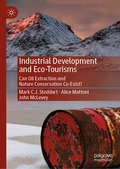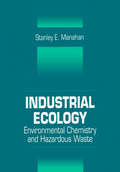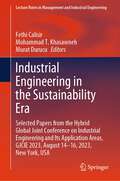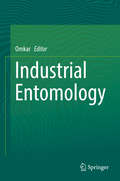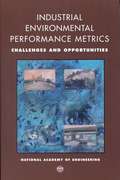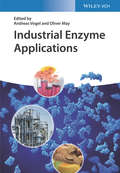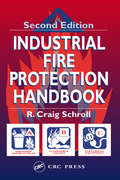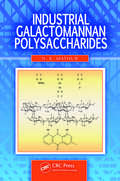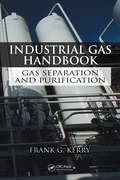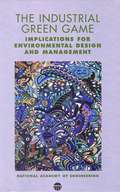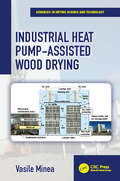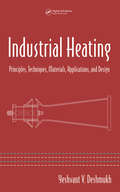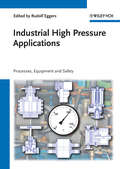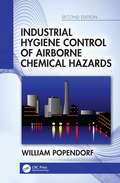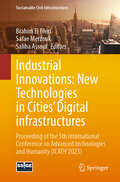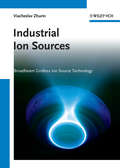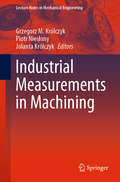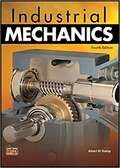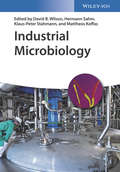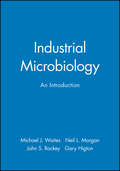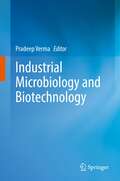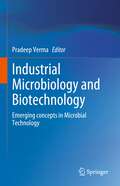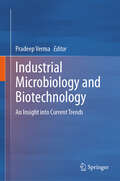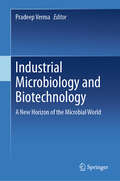- Table View
- List View
Industrial Development and Eco-Tourisms: Can Oil Extraction and Nature Conservation Co-Exist?
by Mark C.J. Stoddart Alice Mattoni John McLeveyThis book examines the “oil-tourism interface”, the broad range of direct and indirect contact points between offshore oil extraction and nature-based tourism. Offshore oil extraction and nature-based tourism are pursued as development paths across the North Atlantic region. Offshore oil promises economic benefits from employment and royalty payments to host societies, but is based on fossil fuel-intensive resource extraction. Nature-based tourism, instead, is based on experiencing natural environments and encountering wildlife, including whales, seals, or seabirds. They share social-ecological space, such as oceans, coastlines, cities and towns where tourism and offshore oil operations and offices are located. However, they rarely share cultural or political space, in terms of media coverage, public debate, or policy discussion that integrates both modes of development. Through a comparative analysis of Denmark, Iceland, Newfoundland and Labrador, Norway, and Scotland, this book offers important lessons for how coastal societies can better navigate relationships between resource extraction and nature-based tourism in the interests of social-ecological wellbeing.
Industrial Ecology: Environmental Chemistry and Hazardous Waste
by Stanley E. ManahanIndustrial ecology may be a relatively new concept - yet it's already proven instrumental for solving a wide variety of problems involving pollution and hazardous waste, especially where available material resources have been limited.By treating industrial systems in a manner that parallels ecological systems in nature, industrial ecology provides a substantial addition to the technologies of environmental chemistry.Stanley E. Manahan, bestselling author of many environmental chemistry books for Lewis Publishers, now examines Industrial Ecology: Environmental Chemistry and Hazardous Waste. His study of this innovative technology uses an overall framework of industrial ecology to cover hazardous wastes from an environmental chemistry perspective.Chapters one to seven focus on how industrial ecology relates to environmental science and technology, with consideration of the anthrosphere as one of five major environmental spheres. Subsequent chapters deal specifically with hazardous substances and hazardous waste, as they relate to industrial ecology and environmental chemistry.
Industrial Engineering in the Sustainability Era: Selected Papers from the Hybrid Global Joint Conference on Industrial Engineering and Its Application Areas, GJCIE 2023, August 14–16, 2023, New York, USA (Lecture Notes in Management and Industrial Engineering)
by Fethi Calisir Mohammad T. Khasawneh Murat DurucuThis book gathers extended versions of the best papers presented at the Global Joint Conference on Industrial Engineering and Its Application Areas (GJCIE), held on August 14-16, 2023, in New York, USA. Continuing the tradition of previous volumes, it highlights recent developments of industrial engineering and digital and intelligent technologies for improving manufacturing processes, and healthcare and transportation services, among others applications. A special emphasis is given to engineering methods and strategies fostering a sustainable business development.
Industrial Entomology
by OmkarThis book is a compilation of writings focused on conventional and unconventional insect products. Some of these products are commercials successes, while others are waiting to be launched and are the potential produce of the future. In addition to the well known products honey, mulberry silk, and lac, the book primarily concentrates on silk producing insects other than the mulberry silkworm, insects as food, as sources of medicines, pest and weed managers, and as pollinators. The book highlights the all pervasive role of insects in improving human lives at multiple levels. Accordingly, while most books on insects concentrate on how to limit growth in their population, it instead focuses on how to propagate them. In each chapter, the book brings to the fore how insects are far more beneficial to us than their well publicised harmful roles. This book approaches both unconventional and conventional insect products, such as honey, silk and lac in much more depth than the available literature. It investigates different aspects of the production of these insects, such as the related processes, problems and utilities, in dedicated chapters. Because this book deals with the production of insects or their produce, it has been named Industrial Entomology, perhaps the only book that truly reveals the tremendous potential of insects to help humans live better lives. Based on the research and working experience of the contributors, who are global experts in their respective fields, it provides authentic, authoritative and updated information on these topics. The book offers a unique guide for students, teachers, policy planners, small scale industrialists, and government ministries of agriculture and industry across the globe. It will provide a much required stimulus to insect appreciation and generate enthusiasm for research and the broader acceptance for insect produce. Hopefully, it will also present the Indian perspective on these topics to a global readership.
Industrial Environmental Performance Metrics: Challenges and Opportunities
by National Academy of EngineeringIndustrial Environmental Performance Metrics is a corporate-focused analysis that brings clarity and practicality to the complex issues of environmental metrics in industry. The book examines the metrics implications to businesses as their responsibilities expand beyond the factory gate--upstream to suppliers and downstream to products and services. It examines implications that arise from greater demand for comparability of metrics among businesses by the investment community and environmental interest groups. The controversy over what sustainable development means for businesses is also addressed.Industrial Environmental Performance Metrics identifies the most useful metrics based on case studies from four industries--automotive, chemical, electronics, and pulp and paper--and includes specific corporate examples. It contains goals and recommendations for public and private sector players interested in encouraging the broader use of metrics to improve industrial environmental performance and those interested in addressing the tough issues of prioritization, weighting of metrics for meaningful comparability, and the longer term metrics needs presented by sustainable development.
Industrial Enzyme Applications
by Andreas VogelThis reference is a "must-read": It explains how an effective and economically viable enzymatic process in industry is developed and presents numerous successful examples which underline the efficiency of biocatalysis.
Industrial Espionage: Developing a Counterespionage Program
by Daniel J. BennyThe FBI estimates that billions of U.S. dollars are lost each year to foreign and domestic competitors who deliberately target industrial trade secrets. And, although today‘s organizations face unprecedented threats to the security of their proprietary information and assets, most books on industrial espionage fail to supply guidelines for establis
Industrial Fire Protection Handbook
by R. Craig SchrollFundamentally, fire prevention and control refer to systems and practices that increase a facility's ability to avoid fires, limit the development and spread of fires, and rapidly and effectively control fires. Changing safety codes and regulations along with recent technological advances have rendered the first edition of this popular handbook som
Industrial Galactomannan Polysaccharides
by N. K. MathurQuite possibly the first comprehensive text on galactomannans, Industrial Galactomannan Polysaccharides compiles information on their industrial uses in the form of gums including locust bean, guar, tara, fenugreek, cassia-tara, and Sesbania-bisipinasa varieties. The book describes how galactomannans are currently produced commercially and how they
Industrial Gas Handbook: Gas Separation and Purification
by Frank G. KerryDrawing on Frank G. Kerry's more than 60 years of experience as a practicing engineer, the Industrial Gas Handbook: Gas Separation and Purification provides from-the-trenches advice that helps practicing engineers master and advance in the field. It offers detailed discussions and up-to-date approaches to process cycles for cryogenic separation of
The Industrial Green Game: Implications For Environmental Design And Management
by Deanna J. Richards National Academy of Engineering StaffIndustrial ecology is a concept that has emerged in response to growing public concern about the impact of industry on the environment. In this framework the natural flow (or circulation) of materials and energy that takes place in biological ecosystems becomes a model for more efficient industrial "metabolism." What industrial ecology is and how it may be applied to corporate environmentalism are the subject of The Industrial Green Game.This volume examines industrial circulation of materials, energy efficiency strategies, "green" accounting, life-cycle analysis, and other approaches for preventing pollution and improving performance. Corporate leaders report firsthand on "green" efforts at Ciba-Geigy, Volvo, Kennecott, and Norsk Hydro. And an update is provided on the award-winning industrial symbiosis project in Kalundborg, Denmark.The Industrial Green Game looks at issues of special concern to business, such as measuring and shaping public perceptions and marketing "green" products to consumers. It offers discussions of the appropriate roles of government and private business.
Industrial Heat Pump-Assisted Wood Drying (Advances in Drying Science and Technology)
by Vasile MineaThis book discusses conventional as well as unconventional wood drying technologies. It covers fundamental thermophysical and energetic aspects and integrates two complex thermodynamic systems, conventional kilns and heat pumps, aimed at improving the energy performance of dryers and the final quality of dried lumber. It discusses advanced components, kiln energy requirements, modeling, and software and emphasizes dryer/heat pump optimum coupling, control, and energy efficiency. Problems are included in most chapters as practical, numerical examples for process and system/components calculation and design. The book presents promising advancements and R&D challenges and future requirements.
Industrial Heating: Principles, Techniques, Materials, Applications, and Design
by Yeshvant V. DeshmukhIndustry relies on heating for a wide variety of processes involving a broad range of materials. Each process and material requires heating methods suitable to its properties and the desired outcome. Despite this, the literature lacks a general reference on design techniques for heating, especially for small- and medium-sized applications. Industri
Industrial High Pressure Applications: Processes, Equipment, and Safety
by Rudolf EggersIndustrial high pressure processes open the door to many reactions that are not possible under 'normal' conditions. These are to be found in such different areas as polymerization, catalytic reactions, separations, oil and gas recovery, food processing, biocatalysis and more. The most famous high pressure process is the so-called Haber-Bosch process used for fertilizers and which was awarded a Nobel prize. Following an introduction on historical development, the current state, and future trends, this timely and comprehensive publication goes on to describe different industrial processes, including methanol and other catalytic syntheses, polymerization and renewable energy processes, before covering safety and equipment issues. With its excellent choice of industrial contributions, this handbook offers high quality information not found elsewhere, making it invaluable reading for a broad and interdisciplinary audience.
Industrial Hygiene Control of Airborne Chemical Hazards, Second Edition
by William PopendorfAre you a practicing occupational hygienist wondering how to find a substitute organic solvent that is safer to use than the hazardous one your company is using? Chapter 6 is your resource. Are you a new hygienist looking for an alternative technology as a nonventilation substitute for an existing hazard? Chapter 8 is your resource. Are you looking for an overview of ventilation? Chapters 10 and 11 are your resource? Are you an industrial hygiene student wanting to learn about local exhaust ventilation? Chapters 13 through 16 are your resource. Are you needing to learn about personal protective equipment and respirators? Chapters 21 and 22 are your resources. This new edition brings all of these topics and more right up-to-date with new material in each chapter, including new governmental regulations. While many of the controls of airborne hazards have their origins in engineering, this author has been diligent in explaining concepts, writing equations in understandable terms, and covering the topics of non-ventilation controls, both local exhaust and general ventilation, and receiver controls at the level needed by most IHs without getting too advanced. Taken as a whole, this book provides a unique, comprehensive tool to learn the challenging yet rewarding role that industrial hygiene can play in controlling airborne chemical hazards at work. Most chapters contain a set of practice problems with the solutions available to instructors. Features Written for the novice industrial hygienist but useful to prepare for ABIH certification Explains engineering concepts but requires no prior engineering background Includes specific learning goals that differentiate the depth of learning appropriate to each topic within the fuller information and explanations provided for each chapter Contains updated governmental regulations and abundant references Presents a consistent teaching philosophy and approach throughout the book Deals with both ventilation and non-ventilation controls
Industrial Innovations: Proceeding of the 5th International Conference on Advanced technologies and Humanity (ICATH'2023) (Sustainable Civil Infrastructures)
by Brahim El Bhiri Safae Merzouk Saliha Assoul“Industrial Innovations: New Technologies in Cities' Digital Infrastructures” is a comprehensive proceedings book that delves into the latest research and practices shaping the industrial landscape in urban settings. In today's rapidly evolving technological landscape, the integration of digital advancements has become increasingly crucial for optimizing industrial processes and enhancing efficiency. Through a series of insightful contributions, this book explores various aspects of digital advancements in industrial processes. Readers will gain valuable insights into topics such as machine learning for export pattern identification, AI-driven predictive maintenance methods, and the integration of digital technologies in distribution supply chains. These discussions shed light on how digital innovations are revolutionizing traditional industrial practices, leading to more streamlined operations and improved outcomes. Additionally, the book examines the role of digital twins in improving business processes by providing virtual simulations and optimizations. This concept enables businesses to enhance their operational efficiency and make informed decisions based on real-time data analysis. Moreover, the impact of digital visual management systems on workplace safety is explored, highlighting the importance of leveraging technology to mitigate risks and ensure a safer working environment. Furthermore, systematic mapping studies shed light on the intersection of green and digital supply chain innovation. By exploring how digital technologies can be leveraged to create more sustainable industrial practices, these studies offer potential avenues for reducing environmental impact and promoting long-term sustainability in industrial operations. With its diverse range of topics and contributions, “Industrial Innovations: New Technologies in Cities' Digital Infrastructures” serves as a valuable resource for researchers, industry professionals, and policymakers interested in the intersection of technology and industrial innovation in urban environments. It offers insights into the latest advancements and best practices in leveraging digital technologies to optimize industrial processes and drive sustainable development in cities worldwide.
Industrial Ion Sources
by Viacheslav V. ZhurinDue to the large number of uses of ion sources in academia and industry, those who utilize these sources need up to date and coherent information to keep themselves abreast of developments and options, and to chose ideal solutions for quality and cost-effectiveness. This book, written by an author with a strong industrial background and excellent standing, is the comprehensive guide users and developers of ion sources have been waiting for. Providing a thorough refresher on the physics involved, this resource systematically covers the source types, components, and the operational parameters.
Industrial Measurements in Machining (Lecture Notes in Mechanical Engineering)
by Grzegorz M. Królczyk Piotr Niesłony Jolanta KrólczykThis book includes the best papers from two conferences on machining and abrasive machining, organized in Poland on September 11-12, 2019. The chapters discuss classical topics and emerging methods and models in machining, measurement, and quality control. They cover new technologies, such as water jet machining, discuss important topics such as energy efficiency in machining, and analyze different cutting methods, materials and mechanisms.
Industrial Mechanics
by Albert W. KempIndustrial Mechanics is a comprehensive introduction to industrial mechanical principles, components, and circuits. This textbook provides information on safety and system efficiency and is designed as a training resource for mechanics, technicians, maintenance personnel, and individuals in industrial training programs. <p><p>This edition includes content on test tool safety and fastening methods, as well as expanded content on electrical safety, electrical applications, hydraulic component testing, and hydraulic system troubleshooting.
Industrial Microbiology
by K. Peter StahmannFocusing on current and future uses of microbes as production organisms, this practice-oriented textbook complements traditional texts on microbiology and biotechnology. The editors have brought together leading researchers and professionals from the entire field of industrial microbiology and together they adopt a modern approach to a well-known subject. Following a brief introduction to the technology of microbial processes, the twelve most important application areas for microbial technology are described, from crude bulk chemicals to such highly refined biomolecules as enzymes and antibodies, to the use of microbes in the leaching of minerals and for the treatment of municipal and industrial waste. In line with their application-oriented topic, the authors focus on the "translation" of basic research into industrial processes and cite numerous successful examples. The result is a first-hand account of the state of the industry and the future potential for microbes in industrial processes. Interested students of biotechnology, bioengineering, microbiology and related disciplines will find this a highly useful and much consulted companion, while instructors can use the case studies and examples to add value to their teaching.
Industrial Microbiology: An Introduction
by Michael J. Waites Neil L. Morgan John S. Rockey Gary HigtonOf major economic, environmental and social importance, industrial microbiology involves the utilization of microorganisms in the production of a wide range of products, including enzymes, foods, beverages, chemical feedstocks, fuels and pharmaceuticals, and clean technologies employed for waste treatment and pollution control. Aimed at undergraduates studying the applied aspects of biology, particularly those on biotechnology and microbiology courses and students of food science and biochemical engineering, this text provides a wide-ranging introduction to the field of industrial microbiology. The content is divided into three sections: key aspects of microbial physiology, exploring the versatility of microorganisms, their diverse metabolic activities and products industrial microorganisms and the technology required for large-scale cultivation and isolation of fermentation products investigation of a wide range of established and novel industrial fermentation processes and products Written by experienced lecturers with industrial backgrounds, Industrial Microbiology provides the reader with groundwork in both the fundamental principles of microbial biology and the various traditional and novel applications of microorganisms to industrial processes, many of which have been made possible or enhanced by recent developments in genetic engineering technology. A wide-ranging introduction to the field of industrial microbiology Based on years of teaching experience by experienced lecturers with industrial backgrounds Explains the underlying microbiology as well as the industrial application. Content is divided into three sections: 1. key aspects of microbial physiology, exploring the versatility of microorganisms, their diverse metabolic activities and products 2. industrial microorganisms and the technology required for large-scale cultivation and isolation of fermentation products 3. investigation of a wide range of established and novel industrial fermentation processes and products
Industrial Microbiology and Biotechnology
by Pradeep VermaIndustrial microbiology utilizes microorganisms to produce industrially important products in a more sustainable way, as opposed to the traditional chemical and energy intensive processes. The present book is an attempt to provide its readers with compiled and updated information in the area of Industrial Microbiology and Biotechnology. This book provides the basics of microbiology and how it has been exploited at an industrial scale. The book focuses on the role of biotechnological advances that directly impact the industrial production of several bioactive compounds using microbes-based methods under a controlled and regulated environment. On one hand, this book presents detailed information on the basics of microbiology such as types of microbes and their applications, bioreactor design, fermentation techniques, strain improvement strategies, etc. At the same time it also provides recent and updated information on industrial production, recovery, and applications of enzymes, alcohols, organic acids, steroids as a drug precursor, etc., using microbial biotechnological approaches. The book presents an overview of modern technological advances for the generation of energy (biomethane, bioethanol, and bioelectricity) and resource recovery from waste. It also highlights the application of CRISPR-based technologies in the industrial microbiology sector. This book is developed with the motive to benefit students, academicians, as well as researchers. The book will also find interests among microbiologists, biotechnologists, environmentalists, and engineers working in the application of the microbes-based approach for the development of greener technologies.
Industrial Microbiology and Biotechnology: Emerging concepts in Microbial Technology
by Pradeep VermaThe second volume of the Book-Industrial Microbiology and Biotechnology covers various emerging concepts in microbial technology which have been developed to harness the potential of the microbes. The book examines the microbes-based products that have widespread applications in various domains i.e., agriculture, biorefinery, bioremediation, pharmaceutical, and medical sectors. It focusses on recent advances and emerging topics such as CRISPR technology, advanced topics of genomics, including functional genomics, metagenomics, metabolomics, and structural and system biology approaches for enhanced production of industrially relevant products. It further gives an insight into the advancement of genetic engineering with special emphasis on value-added products via microalgal systems and their techno-economics analysis and life cycle assessment. The book towards the end presents recent advancements in the use of microbes for the production of industrial relevant enzymes, amino acids, vitamins, and nutraceuticals, on vaccine development and their biomedical applications. The book is an essential source for researchers working in allied fields of microbiology, biotechnology, and bioengineering.
Industrial Microbiology and Biotechnology: An Insight into Current Trends
by Pradeep VermaThis book provides an in-depth exploration of microbial biodiversity and its crucial role in diverse biotechnological and industrial sectors. It covers topics such as the integration of molecular approaches for identifying industrially significant strains, omics roles in the production of bioproducts, and modern genetic engineering techniques. It discusses biostatistical investigations and the impact of microbial biotechnology on healthcare and emerging contaminants. It highlights the significance of food microbiology, fermentation, and the latest technologies in improving human health. Additionally, the book delves into emerging trends in oligosaccharide production, biobased approaches for a sustainable future, and the importance of microbial biomolecules and secondary metabolites. It also explores the identification and production of industrially significant biocatalysts/enzymes, the valorization of agro-industrial waste using microorganisms for green energy generation, and the development of bioreactor systems for the biobased economy. The book covers advancements in solid-gaseous biofuels production, impact assessment of synthetic microfiber pollution, sustainable management strategies for waste management, and the impact of emerging technologies in medical microbiology. The book also discusses the development of healthcare products using nano-biotechnological advancements, the impact of novel remediation technology, and the utilization of microbial products in biomaterial development. It further explores microbial regulatory systems, gene expression studies, and the significance of mutations in microbial technology. This book serves as a great reference for researchers, environmentalists, microbiologists, biotechnologists, and graduate, post-graduate students, and doctoral students working on microbial biotechnology and industrial microbiology.
Industrial Microbiology and Biotechnology: A New Horizon of the Microbial World
by Pradeep VermaThis book is a comprehensive guide for industrial bioprocess development, covering major aspects of microbial processes and their role in biotechnology. It provides a selection of hyperproducers, microbial products, and metabolic engineering strategies for industrial production. It covers high cell density cultivation techniques product formation kinetics measurement and limiting parameters in large-scale process development. The first and second section of the book focuses on biotechniques, including spectroscopic concepts of light, wave, and electromagnetic theory, as well as absorption, fluorescence, phosphorescence, infrared, and Raman spectroscopy. It also covers the basic principles, concepts, biological applications, and other advanced techniques. The third section emphasizes microbial inventions and improvements in bioprocess development. It covers microbial products and recent developments in fermentation technology and also includes information on metabolic engineering. The fourth section related to microbial inventions and bioprocesses which include platforms for recombinant gene expression, as well as the development of recombinant heterologous expression systems such as E. coli, yeast, mammalian and insect cells, and plant cells used as biofactories. The fifth section of the book focuses on microbial product waste management in extreme environments, biomass waste management, bio-pulping, bio-bleaching, textiles, biofuels, and animal feed production. The book aims to provide a multidisciplinary opportunity on all aspects of microbial biotechnology. It covers recent international developments that have renewed interest in industrial microbiology and biotechnology. The book is suitable for teachers, researchers, graduate and post-graduate students, environmentalists, microbiologists, and biotechnologists.
